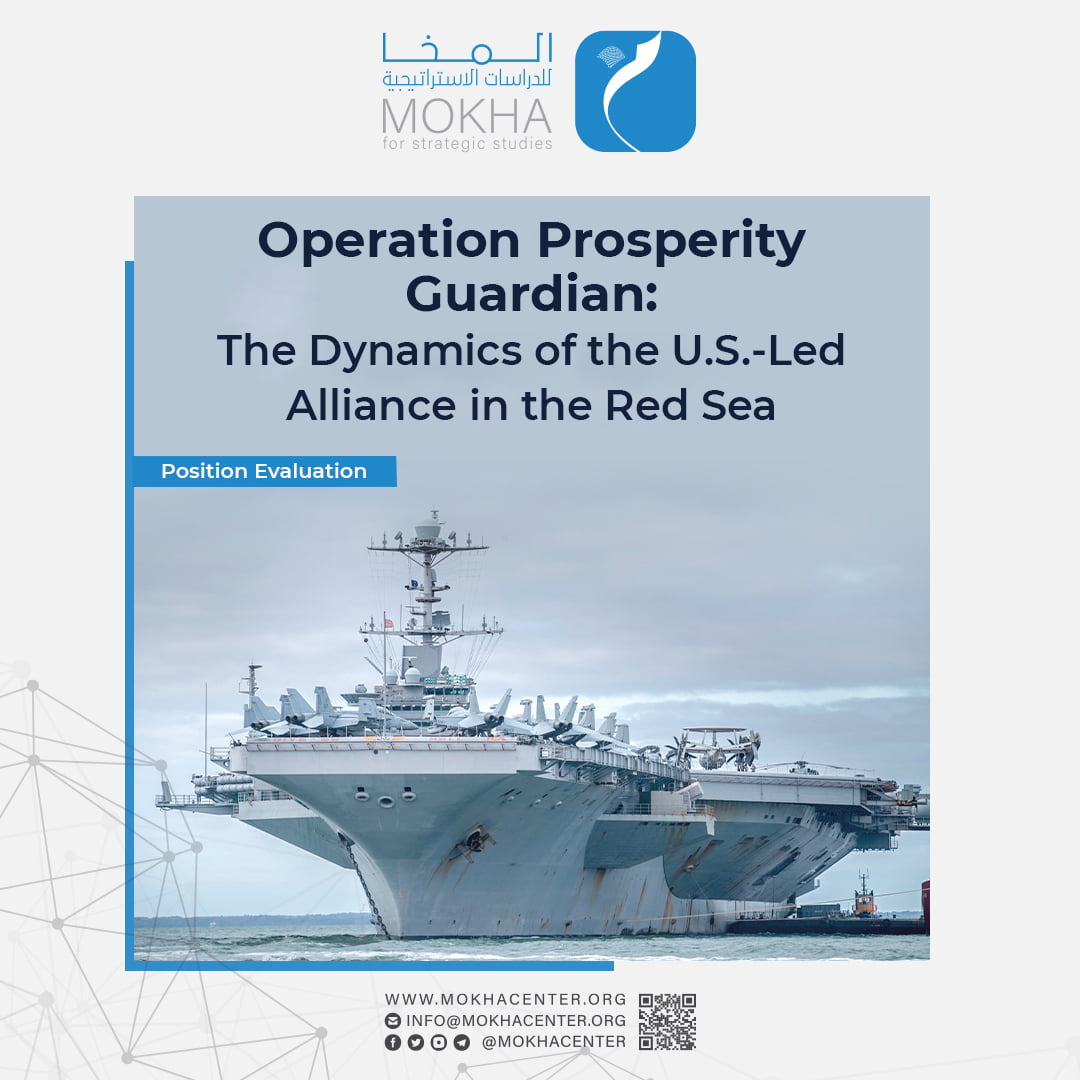Operation Prosperity Guardian: The Dynamics of the U.S.-Led Alliance in the Red Sea

| Getting your Trinity Audio player ready... |
On December 19, 2023, U.S. Secretary of Defense Lloyd Austin announced the initiation of an operation involving a multinational force aimed at safeguarding trade in the Red Sea. This decision followed a series of missile and drone attacks orchestrated by the Houthis on commercial ships in the Red Sea. Named Operation Prosperity Guardian by the U.S. Department of Defense, it incorporates joint patrols. The secretary urged dozens of countries to act against any Houthi attacks on ships in the Red Sea.1
Although Washington, D.C., asserted that 20 countries had joined this initiative, the call was met with indifference from Arab nations, reluctance from some Western countries, and rejection from others. This response was shaped by the ongoing Israeli offensive in the Gaza Strip, and the insistence of the United States on continuing the conflict.
What characterizes this operation? What role can it play, and what are the potential consequences stemming from its establishment?
Context Analysis:
Over the past eight years of conflict, the Houthis have, to some extent, advanced their military capabilities, particularly in missiles and drones, with the support of Iran. These capabilities were employed to target the strategic interests of Saudi Arabia and the United Arab Emirates in the latter years of the conflict.
Following Israel’s aggression against the Gaza Strip after the Al-Aqsa Flood operation on October 7, 2023, the Houthis seized an opportunity to use their missiles and drones for propaganda purposes. This aligns with their role within the Axis of Resistance, led by Iran. On November 19, 2023, they intercepted a cargo ship and brought it to the Yemeni coast2, launching subsequent operations targeting commercial ships passing through the Bab al-Mandab Strait.
As these attacks intensified, major shipping companies rerouted their vessels away from the Red Sea waters, redirecting them toward the Cape of Good Hope and circumventing the African continent altogether. The United States condemned the Houthi attacks and attempted to assist certain ships in countering their ongoing assaults. However, with the persistence of these operations, Washington declared consultations to establish a multilateral international force to safeguard cargo ships transiting the Red Sea.
During the U.S. Secretary of Defense’s visit to the Middle East, the formation of a multinational force was announced, comprising such countries as Britain, Bahrain, Canada, France, Italy, the Netherlands, Norway, Seychelles and Spain. This coalition will conduct joint patrols in the southern Red Sea and the Gulf of Aden, implementing Operation Prosperity Guardian to ensure freedom of navigation and to bolster regional3 security in the Red Sea and Gulf of Aden.
In response to the American announcement, several countries expressed reservations about joining the multinational force, even among those initially included by the U.S. Department of Defense. France, while expressing support for efforts to ensure freedom of navigation in the Red Sea, clarified that its ships would remain under French command as they were already operating in the region. Italy stated that it would dispatch the naval frigate Virginio Fasan to the Red Sea in response to specific requests from Italian shipowners. More importantly, Italy emphasized that this action is part of its ongoing operations and not directly linked to Operation Prosperity Guardian.
Spain, notably vocal in rejecting participation, outlined its stance, noting it would only engage in missions led by NATO or operations coordinated by the European Union. It expressed reluctance to participate unilaterally in the Red Sea operation4. Conversely, Britain declared its intention to join the destroyer HMS Diamond in Operation Prosperity Guardian. The coalition, according to the announcement, would operate as part of the combined naval forces led by the United States.5 Similarly, Greece announced plans to dispatch a naval frigate to the Red Sea, aligning it with Operation Prosperity Guardian6.
The Netherlands and Norway disclosed their plans to send several naval officers to Bahrain, where the headquarters of the Joint Maritime Forces is located7. This decision reflects their contribution to the multinational effort to maintain maritime security in the region.
Except for Bahrain, the host of the U.S. Fifth Fleet, no Arab nations, including Saudi Arabia, Egypt and the United Arab Emirates, have joined this alliance. Egyptian Foreign Minister Sameh Shoukry stated that the countries bordering the Red Sea have a shared responsibility to safeguard it. He emphasized that Egypt remains committed to collaborating with various partners to create favorable conditions for ensuring freedom of navigation in the Red Sea. Meanwhile, Saudi Arabia, along with other Arab nations, has opted for a silent stance, likely influenced by the following considerations:
While Arab countries have a vested interest in ensuring the security of international navigation in the Red Sea, they decided not to join an alliance perceived as safeguarding Israel’s interests amid its extensive aggression against Palestinians in Gaza and the West Bank.
Arab nations observed that the United States’ action against the Houthis is primarily motivated by its self-interests, often disregarding the concerns of its allies. The U.S. applied significant pressure to prevent the National Army of the legitimate authority from controlling the port of Hodeidah in 2017 and compelled coalition countries and the legitimate authority to accept the Stockholm Agreement. Red lines were drawn on the National Army’s advancement toward the capital, Sana’a, according to the Speaker of the Yemeni Parliament.8
Arab countries are cautious about avoiding confrontations with Iran and its regional proxies, as such clashes could inadvertently serve Israel’s aggression against the Gaza Strip.
Saudi Arabia’s desire not to thwart its efforts to push the Yemeni parties to sign an expanded truce agreement. This approach aligns with Saudi Arabia’s focus on advancing its economic capabilities and bolstering its international standing.
Regarding Iran, its rhetoric encompasses various extremes. Iranian Defense Minister Mohammad Reza Ashtiani cautioned the United States, warning of exceptional challenges if it pursued the formation of an international force to protect navigation in the Red Sea. He emphasized that no one could operate in an area where Iran held the upper hand9. The specific strategies Iran might employ to thwart the formation of this force remain unclear.
Role Limitations and Options:
The formation of Operation Prosperity Guardian suggests a defensive orientation, primarily aimed at addressing and mitigating attacks that pose threats to navigation in the Red Sea. Nevertheless, under specific circumstances, there is potential for it to transition into offensive missions, as outlined below:
The First Option is to Secure Ship Routes:
The Pentagon’s announcement regarding the establishment of this operation outlined its mission, which is to collectively address security challenges in the southern Red Sea and the Gulf of Aden. The operation aims to ensure freedom of navigation for all nations, enhance regional security and promote prosperity. This will be carried out in coordination with the Joint Marine Forces and the leadership of Task Force 15310. Specifically, the operation will involve escorting commercial ships, responding to threats, and taking measures to counter naval vessels targeting ships.
This mission aligns with the stated objective of the United States, which is to avoid expanding the conflict in the region and, where possible, confine it to the Gaza Strip. To achieve this goal, the U.S. deployed barges and naval vessels to the White and Red Bahrain, applied significant pressure on regional powers, and demonstrated a high level of containment in response to Houthi attacks.
American policy has effectively pursued its primary objective of preventing the escalation of conflict in the Red Sea through several key measures:
Pressuring Israel to refrain from responding militarily to Houthi actions.
Preventing the initial risk of Houthi attacks.
Establishing a multilateral coalition and seeking international legitimacy for its actions.
Framing Houthi attacks as threats to international shipping, thereby justifying a collective response beyond the United States alone.
Applying pressure on Iran to leverage its influence and discourage Houthi attacks.
The evolving situation suggests that the role of the new maritime alliance will likely remain aligned with this approach. Major shipping companies have altered their routes to navigate via the Cape of Good Hope. The formation of the new force, coupled with regional pressures, appears to have resulted in a reduction in attacks. Notably, the targeting strategy seems deliberate, avoiding direct hits on ships and keeping the incidents within acceptable limits. This approach doesn’t indicate Houthi withdrawal but aims to avoid compelling the United States to respond militarily.
Maintaining this course serves as a shared goal for the United States, Iran and the Houthis. It prevents a direct clash and allows each party to achieve its propaganda objectives. Subsequently, rhetoric has intensified on all sides. Iran continues to caution against the formation of a military alliance in the Red Sea. The U.S. administration has heightened its tone, with the director of the National Economic Council at the White House, Lael Brainard, emphasizing close monitoring of the Red Sea situation and the administration’s vigilance against potential risks. In response, the Houthi leader declared that American battleships would be targeted if the U.S. initiated attacks.
The Second Option is Launching Offensive Operations:
We can call it the “option of necessity,” as the American administration may resort to targeting Houthi missile platforms in Yemen, if it is exposed to a high state of embarrassment or if its soldiers are exposed and its vital interests are harmed. Proceeding with this option will be conditional on the following:
The Houthi attacks continue, putting the American administration under great critical pressure.
Targeting American ships or battleships.
If the attacks lead to the death of American soldiers.
Repercussions:
Irrespective of the trajectory that events take, there will be consequences stemming from this process, including:
Increased Militarization of the Red Sea:
Throughout history, Western countries have demonstrated a keen interest in establishing and expanding their military presence in the Red Sea region, recognizing its significance in global trade, energy and the overall economy. This interest has materialized through successive stages of militarization in the Red Sea region. Besides the American forces present both before and after Operation Al-Aqsa Flood, there are approximately 15 permanent military bases, including six major bases in Djibouti. Alongside these bases, various naval operations and alliances contribute to the militarization, such as:
Operation Atlanta, initiated by the European Union Naval Force in Somalia, operates in the Horn of Africa and the western Indian Ocean to support UN resolutions addressing piracy. Its headquarters is in Spain.
Operation Agenor, a European-led initiative focused on ensuring freedom of navigation in the Strait of Hormuz, a crucial shipping route for oil exports from Gulf states.
Security Division 153 was established in 2022 to combat smuggling and address illegal activities, particularly those deemed terrorist, in the Red Sea, Bab al-Mandab and Gulf of Aden regions.12
Resources:
America forms a force in the Red Sea and changes the course of ships to avoid attacks, Swiss Info, accessed on 12/19/2023, available at the following link: https://cutt.us/R8tqd
The Houthis detain an Israeli ship and Tel Aviv: The incident is very serious, Al Jazeera Net, accessed on 12/19/2023, available at the following link: https://cutt.us/usVXy
America forms a force in the Red Sea and changes the course of ships to avoid attacks, op. cit.
The reason for the rejection appears to be due to the blatant American bias in favor of Israel in its aggression against Gaza, and the keenness of those countries to not appear as if they were involved in the aggression against Gaza by guarding Israeli ships, in light of the widespread popular movement taking place in European countries rejecting the war and demanding it stop.
The American task force in the Red Sea enjoys limited support from some allies, Swiss Info, accessed on 12/20/2023, available at the following link: https://cutt.us/2BqLy
Greece sends a frigate to the Red Sea to protect navigation, Swiss Info, accessed on 12/1/2023, available at the following link: https://cutt.us/XXrKd
U.S. Red Sea Task Force enjoys limited support from some allies, op. cit.
Sultan Al-Barakani: Washington refused the Yemeni army’s entry into Sana’a and informed the government that this was a red line, Belqis website, accessed on: 12/5/2022, available at the following link: https://cutt.us/cvQve
Iran warns America of the consequences of forming an international force in the Red Sea, Al Jazeera Net, accessed on: 12/14/2023, available at this link: https://cutt.us/n6WUt
Saudi Arabia, Egypt and the Emirates. Why did they distance themselves from the “Protector of Prosperity” in the Red Sea? Al Hurra Channel, accessed on 12/20/2023, and available at the following link: https://cutt.us/GTpZv
The White House: The Biden administration is closely monitoring the situation in the Red Sea, Ma’an News website, accessed on 12/22/2023, available at the following link: https://www.maannews.net/news/2108643.html
U.S. Red Sea task force enjoys limited support from some allies, Swiss Info, op. cit. Click to download the article




